 |
||||||||||||
What "Fuels" a Wildfire?
|
||||||||||||
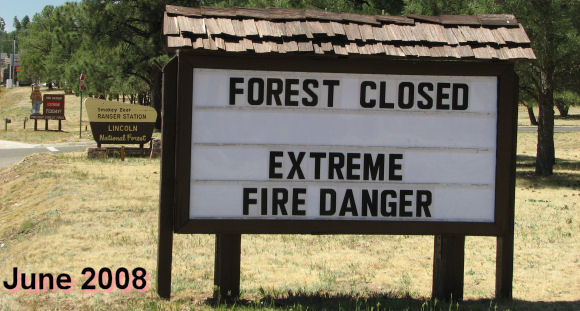 |
||||||||||||
| Fuels are one of three main components which drive wildfires. The other two are terrain and weather. Fuels can be split up into two classes or components: live and dead. An example of live fuels is shown in photo below and to the left with green shrubs and grasses evident in the landscape near San Ysidro. The dead component is illustrated in the photo below and to the right showing an example of a "jungle" of dead sticks that rats pile up and live in. |
||||||||||||
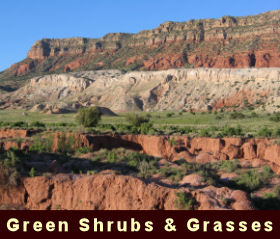 |
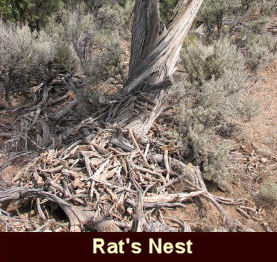 |
|||||||||||
| The live component is generally related to the growing season or green-up period. During the course of the year across New Mexico there are typically one or two green-up periods (spring and summer) with a dormant period during winter. |
||||||||||||
| Typically, during the month of June, fuels across the lower elevations (see photo to the right) are either cured or curing, that is, drying. This includes annual grasses, weeds and forbs. Woody shrubs will also observe lowering moisture levels as intense heating and drying during this period begins the curing process. |  |
|||||||||||
 |
A transition occurs in higher elevations where grasses can still be fairly green although there is some slight drying. The woody shrubs across the higher elevations tend to be fairly green (see photo to the left) and typically contain higher moisture levels. During significant drought years, less moisture is found within the growing or live fuels. This promotes fire spread after lightning or human ignition. |
|||||||||||
| The dead fuel component also contributes to fire ignition and spread. This includes the "duff layer", which is comprised of several years worth of accumulating needlecast and leaf litter. The photo below on the left shows a combination of leaf litter and needlecast left, while the photo on the right illustrates a full layer of only needlecast. |
||||||||||||
 |
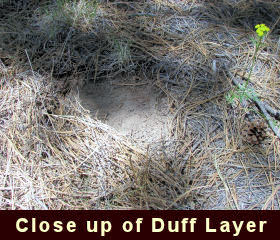 |
|||||||||||
| The drier and deeper the duff layer, as well as the drier the soil, the more susceptible this fuel bed is to lightning strikes. Fire will smolder for days and even weeks within a dry and deep duff layer. The photos below illustrate a contrast in that both depict a dry and deep duff layer, but soil is exceptionally dry in the left image and has some moisture evident in the right photo. Crackling duff and powdery soil as indicated by the video below represent a very efficient lightning ignition source. |
||||||||||||
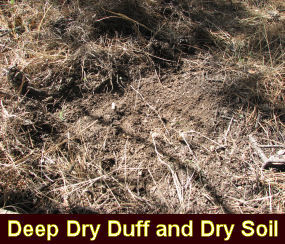 |
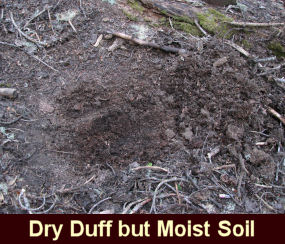 |
|||||||||||
| The dead fuel component is also comprised of wood logs and twigs. These photos illustrate a "Punky Log", or a dead rotting log on the forest floor. Look carefully at the close up on the right to see that while the outside of the log is dry fuel, there is some moisture in the middle of the log. When dry, these types of logs are efficient lightning ignition sources. |
||||||||||||
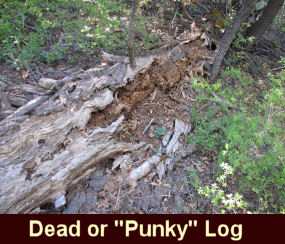 |
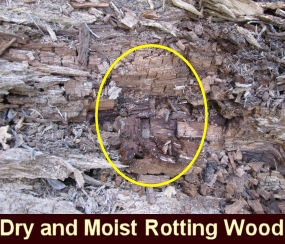 |
|||||||||||
| The dead fuel component does not need to be on the surface but can also include dead limbs on trees (photo below and left) as well as "snags", or dead fuel still upright (photo below and right). Snags, especially tall ones,are susceptible to lightning strikes as they contain ample amounts of dead wood that lightning can easily ignite. Typically, during the month of June, the dead fuel component is at its driest levels for the year. The drier the dead fuel component, the more susceptible this fuel regime is to lightning ignitions. |
||||||||||||
 |
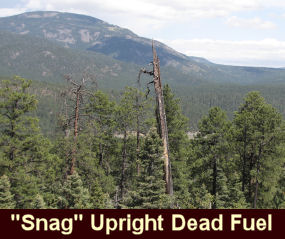 |
|||||||||||
| The moist portion of the monsoon will act to raise moisture levels within the dead fuels and generally promotes green-up in various live species such as perennial grasses. The overall effect of the moist monsoon is a reduction in lightning fire ignitions and a reduction in spread after ignition. | ||||||||||||